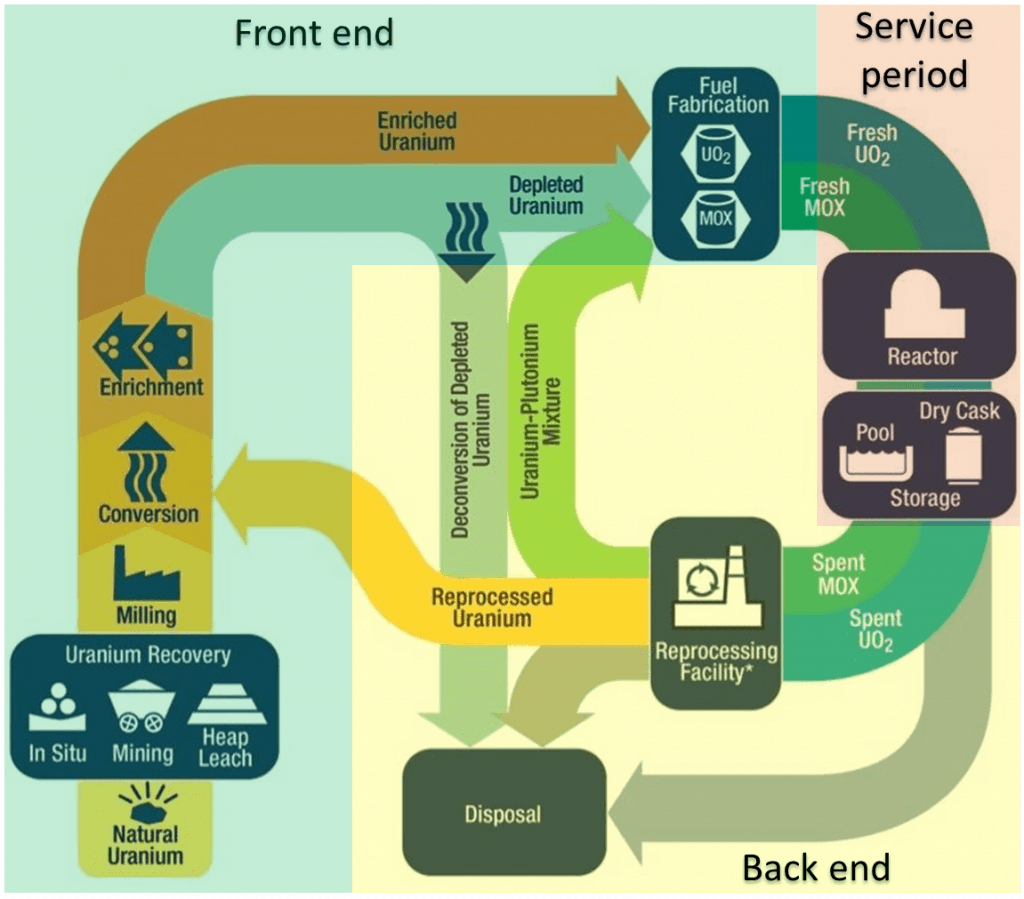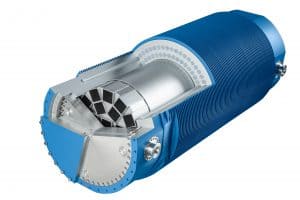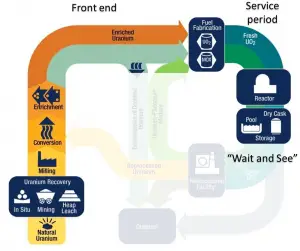
Spent nuclear fuel, also called the used nuclear fuel, is a nuclear fuel that has been irradiated in a nuclear reactor (usually at a nuclear power plant or an experimental reactor), and a fresh fuel must replace that due to its insufficient reactivity.
Irradiated fuel is due to the presence of a high amount of radioactive fission fragments and transuranic elements that are very hot and very radioactive. Reactor operators must manage the heat and radioactivity that remains in the “spent fuel” after it’s taken out of the reactor. In nuclear power plants, spent nuclear fuel is stored underwater in the spent fuel pool on the plant. Plant personnel moves the spent fuel underwater from the reactor to the pool. Over time, as the spent fuel is stored in the pool, it becomes cooler as the radioactivity decays away. After several years (> 5 years), decay heat decreases under specified limits so that spent fuel may be reprocessed or interim storage. At first glance, it isn’t easy to recognize fresh fuel from used fuel. From a mechanical point of view, the used fuel (irradiated) is identical to the fresh fuel. In most PWRs, used fuel assemblies stand between four and five meters high, are about 20 cm across, and weigh about half a tonne. In contrast to the fresh fuel, which is simply shiny, the oxide layer forming on the surface of used fuel assemblies during the four-year fuel cycle makes them dark. Moreover, Cherenkov radiation is typical only for spent nuclear fuel. The glow is also visible after the chain reaction stops (in the reactor). The Cherenkov radiation can characterize the remaining radioactivity of spent nuclear fuel. Therefore it can be used for measuring fuel burnup.
The back end of the nuclear fuel cycle involves managing the spent fuel after irradiation. Therefore, the back end of the fuel cycle consists of:
- Spent interim fuel storage. Currently, spent fuel is being stored in at-reactor (AR) or away-from-reactor (APR) storage facilities, and we can identify two basic solutions for interim storage:
-
- Dry Storage
- Wet Storage
- Fuel reprocessing,
- Final disposal of radioactive waste or spent fuel.
There are three main types of nuclear fuel cycle:
- Once-through fuel cycle. An open fuel cycle is not a real cycle, and this strategy assumes that the fuel is used once and sent to long-term storage without further reprocessing. If spent fuel is not reprocessed, the fuel cycle is referred to as an open fuel cycle or a once-through fuel cycle as the uranium components go through the reactor just one single time. The once-through cycle comprises two main back-end stages:
- interim storage
- final disposal.
- Twice-through fuel cycle. The twice-through cycle strategy assumes that the spent nuclear fuel will be reprocessed to extract the uranium and plutonium, which can be recycled as fresh nuclear fuel for use in a nuclear reactor adapted to this type of fuel.
- Closed fuel cycle. The closed fuel cycle is an advanced fuel cycle whose purpose is to achieve nuclear power sustainability by further reducing the final waste’s radiotoxicity and improving resource utilization while maintaining its economic viability. There are currently different types of advanced fuel cycles under research, but most of them are based on the use of:
- Advanced Nuclear Reactors
- Fuel Reprocessing

These fuel strategies are based on specific processes in the entire fuel cycle (the back end, the front end, and the service period). All these scenarios are theoretical, and the practical solution will be, in any case, a combination of these options. In all cases, the fuel assemblies are first after irradiation stored in spent fuel pools at the reactor site for an initial cooling period. Over time, as the spent fuel is stored in the pool, it becomes cooler as the radioactivity decays away. After several years (> 5 years), decay heat decreases under specified limits so that spent fuel may be reprocessed or interim storage. It must be added that any strategy for managing spent nuclear fuel will be built around combinations of many options, and all strategies must ultimately include permanent geological disposal.
The choices of nuclear fuel cycle (open, closed, or partially closed through limited spent fuel recycling) depend upon the technologies we develop and societal weighting of goals (safety, economics, waste management, and nonproliferation). Once choices are made, they will have major and long-term impacts on nuclear power development. Today we do not have sufficient knowledge to make informed choices for the best cycles and associated technologies.
See more: The Future of the Nuclear Fuel Cycle. An interdisciplinary MIT study. MIT, 2011. ISBN 978-0-9828008-4-3.
See more: Deutch, J.M.; Holdren, J.P. The Future of Nuclear Power: An Interdisciplinary MIT Study; Massachusetts Institute of Technology (MIT): Boston, MA, USA, 2003.
Interim Storage of Spent Nuclear Fuel

Interim storage is a temporary solution that plays a central role in managing the most highly radioactive materials: spent nuclear fuel and vitrified waste resulting from reprocessing such fuel. Since spent nuclear fuel is compact, plant operators can store fuel assemblies for a long time. It must be noted that the spent nuclear fuel is due to the presence of a high amount of radioactive fission fragments and transuranic elements that are very hot and very radioactive. Reactor operators must manage the heat and radioactivity that remains in the spent fuel after it’s taken out of the reactor. In nuclear power plants, spent nuclear fuel is stored underwater in the spent fuel pool on the plant. Plant personnel moves the spent fuel underwater from the reactor to the pool. Over time, as the spent fuel is stored in the pool, it becomes cooler as the radioactivity decays away. After several years (> 5 years), decay heat decreases under specified limits so that spent fuel may be reprocessed or interim storage.
Interim Storage and Wait and See

Most countries with nuclear programs use some type of interim storage as their back-end strategy. They have explicitly decided to take a “wait and see” approach to spent fuel management, leaving their spent fuel in interim storage, which leaves both the reprocessing and direct disposal options open for the future. As the name implies, the wait-and-see option proposes interim storage until some solution for permanent storage and disposal is developed in the future. For many operators, the spent fuel also represents a strategic material since the spent nuclear fuel still contains about 96% of reusable material. Storing spent fuel and waste for several years allows heat release and radioactivity to subside. Despite the continued debate over the future of the fuel cycle, a quiet consensus has developed that simply storing spent fuel while developing more permanent solutions is an attractive approach for the near term.
Currently, spent fuel is being stored in at-reactor (AR) or away-from-reactor (APR) storage facilities, and we can identify two basic solutions for interim storage:
- Dry Storage, where natural air circulation dissipates heat.
- Wet Storage, where water is used as the heat conductor.